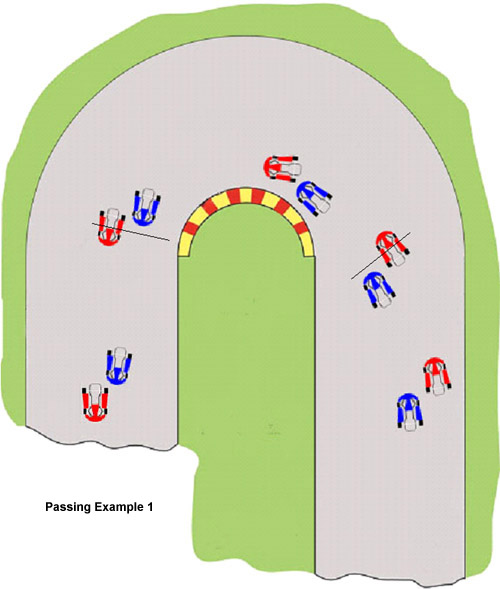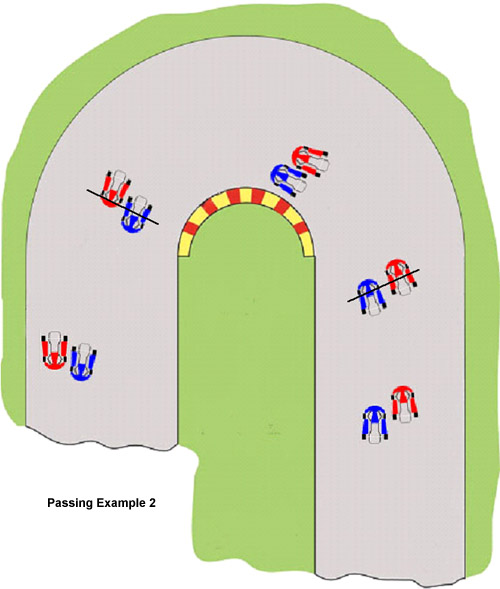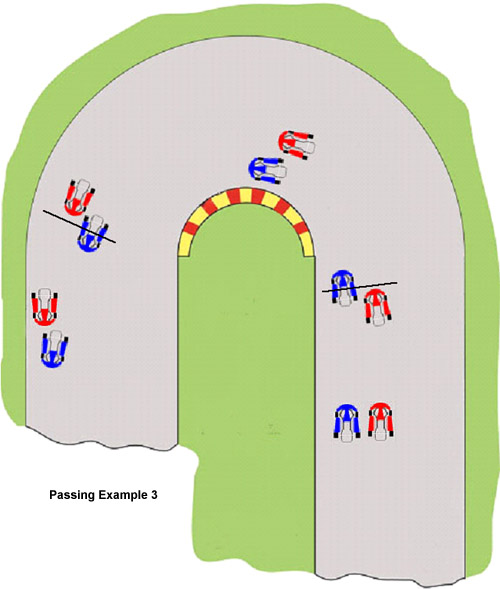| J | COMPETITION RULES |
| J1.1 | TRACK DEFINITION – Competitors must use the track at all times. For the avoidance of doubt the white lines defining the track edges are considered to be part of the track but kerbs are not. A competitor will be judged to have left the track if no part of the kart remains in contact with the track. |
This is the the International CIK track definition.
A kart exceeding the track limits under this rule should be at a disadvantage however don't overlook Rule J1.10, deliberately driving off the track is Dangerous Driving J1.3.
Most complex incidents will occur at the first corner following the start.
A common example of first corner incidents. The white kart does a big dive on the inside going well over the kerb with the two left wheels in the grass (verge). Contact is made which causes the karts on the outside to go all over the track while the white kart continues. An Officials Report is required for this competitor - causing an avoidable contact. |
|
This is a follow on from above. One of the karts pushed off then gives the white kart a big serve, spinning the white kart off the track. This is a separate incident and we call it retaliation. Retaliation is as serious as the original incident and should be the subject of an Officials Report under J1.3. |
|
| J1.2 | CODE OF DRIVING CONDUCT: A high standard of driving behaviour is expected at all times, from the time a kart enters the out grid to the time a kart exits the weigh shed. A kart must be driven at all times within the capabilities and expertise of the competitor. At any time during practices, time trials or racing, any on track action or actions by one or more drivers which unfairly disadvantages another competitor or competitors is not permitted. |
These actions may include but are not limited to:-
• Failure to adhere to ln grid procedures, including any requirements listed in Rule Q5.1 and Rule J2.21
• Failure to respect the requirements for taking the start.
• Impeding or preventing an overtaking manoeuvre by a competitor.
• Changing line more than once on a straight.
• Forcing a competitor off the track.
• Causing an avoidable contact or collision.
• Making an unsafe return or gaining an advantage when returning to the track and not redressing the situation.
• Any careless or reckless driving on the track or out grid/in grid areas.
• Disregarding any flag or light signals.
J1.3 DANGEROUS DRIVING: This includes but is not limited to barging, sudden line changes or causing an avoidable accident.
Application in practice of Rule J1.2 Code of Driving Conduct :-
•The definition of Careless/Reckless Driving is that the driver does not meet the high standard expected of a competent driver.
Application in practice of Rule J1.3 Dangerous Driving
•The definition of Dangerous Driving is an action by a driver which creates a serious risk to others.
The graphic on the right shows a passing move starting and when it is completed. (read the words on the graphic from the bottom up).
J1.2 CODE OF DRIVING CONDUCT This says in part :-
•Impeding or preventing an overtaking manoeuvre
•Causing an avoidable contact or collision is not permitted. |
|
|
|
The passing manoeuvre when entering, once established or exiting the corner generates most of the infringement notices (PNRs) that race officials will deal with.
A passing manoeuvre is deemed to have begun when two (2) karts overlap each other by approximately 50% or more.
You need to understand that it is the responsibility of both karters to avoid contact BUT during a normal passing manoeuvre there is in fact a changing situation as to which karter has the prime responsibility for avoiding contact, ie. giving sufficient racing room. This prime responsibility starts with the kart that is commencing the overtaking manoeuvre, changing to both karts during the middle period of the overtaking manoeuvre and finally changes to the overtaken kart.
Passing Example 1 (at right) At the entry point to the corner if the attacking kart (Blue) does not have at least a 50% overlap on the other kart (Red) he has "lost" the right to that corner. He must give racing room to the Red kart.
|
|
Passing Example 2 (at right) If two karts have 50% or more overlap on each other at the corner entry point and throughout the corner they are both responsible for giving each other sufficient racing room throughout the corner including the corner exit.
|
|
Passing Example 3 (at right)
a)The attacking kart (Blue) has an overlap of 50% or more at the entry point to the corner, he has "won" the right to that corner. b)With both karts approaching the corner exit, the Red kart still has less than a 50% overlap and must give the attacking/passing kart sufficient racing room so that the Blue kart can take the normal racing line at the corner exit.
NOTE: What often occurs at the corner exit is a kart apparently being forced off the track when in fact it had tried to live beside the overtaking kart with less than a 50% overlap and inevitably ran out of track. That kart has the same prime responsibility for avoiding contact as the kart with less than a 50% overlap at the corner entry point. Neither of those two karts have the right to be in that position so they both need to back out of their current positions quickly before they cause an avoidable contact or collision! Refer to Rule J1.2 |
|
This shows a competitor (white kart) making a last second dive into a corner then forcing the outside competitor off the track on the exit of the corner. If an advantage was gained by the white kart, it will result in an Officials Report. |
|
Here it shows a competitor not leaving sufficient racing room (white kart) when it is very clear that the black kart is in a passing move. Officials Report required. |
|
J1.4 WITHDRAWAL from competition or deliberately leaving the track at any time must be clearly indicated with a hand signal.
If a kart malfunctions during a race or practice the competitor must indicate with an upright hand signal that he/she is stopping or is returning to the pits.
| J1.5 | Only certain areas of a circuit are recognised as “safe” areas where a kart may be left attended or unattended. Karts are not permitted to be left on the track or in an “unsafe” area of the outer track, nor may a kart be worked on in these areas. Karts are to be removed from the track and not to be left on the outside of corners or close to the edge of the circuit. Failure to abide by this ruling may result in the competitor being penalised. |
This is a safety issue. Competitors at times are more interested in their own well being and getting themselves into a safe point with out consideration to the well being of other competitors. The black karts in all cases are in unsafe locations. Getting the competitor to a safe position should be a priority however it is also necessary to ensure that the kart is moved to a safe location. The white kart is in a safe location. Only when the driver and kart are in a safe location should the yellow flag be retracted. Also note that competitors are required to keep their helmets on except when in a flag point – however even in this position, leaving the helmet on is preferred. |
|
| J1.6 | OUTSIDE ASSISTANCE: Junior and Senior Age Group competitors may restart during competition provided all safety precautions are observed and no outside assistance is received. |
Junior Restricted and Cadet Age Group competitors are permitted controlled outside assistance to restart using on-board starter motors only.
No tools or starter motors may be taken onto the racing confines once the karts have left the Out Grid unless authorised. A Clerk of the Course/Race Director has the discretion to order a competitor to cease attempting to restart. Failure to comply may result in the competitor being penalised or disqualified.
Pit Crew providing outside assistance must remain within the Flag Point or where directed by the Clerk of the Course/Race Director until a Yellow Flag has been displayed for the respective incident.
The only person who has the authority to allow tools or starter motors into the racing confines is the Race Director/Clerk of the Course. This would only happen when karts are stationary from a red flag.
The Clerk of the Course or an Assistant Clerk of the Course can order a competitor to cease attempting to restart. Not a regulation, but a rule of thumb is two attempts is all that should be permitted.
J1.7 At NO STAGE of driving a kart may both hands be removed from the wheel at the same time.
J1.8 REFUELLING a kart on the grid or the track is not permitted.
J1.9 Under NO CIRCUMSTANCES is a kart permitted to be driven in a direction which is opposite to that of the normal racing direction.
This is not a common occurrence during competition but it happens sometimes after a race has completed when the competitor gives his/her kart a push and it starts. Jumps in and takes the short cut back to the pits. In some of these cases the driver may not have a helmet and/or gloves on. There are no warnings for this breach of rule. This is an automatic Officials Report and penalty applied.
| J1.10 | Competitors who, during competition, inadvertently drive off or are forced off the track, must with caution rejoin the track at the nearest point compatible with the safety of themselves and fellow competitors, provided that their position is not improved unfairly or an advantage gained. |
Deliberately driving off the track is considered dangerous driving.
J1.11 Any twin motored kart that throws a chain during competition will be permitted to complete the race without penalty.
| J1.12 | A kart that obviously will not handle correctly may be called for trial and observation by the Clerk of the Course/Race Director. If there is doubt as to the general safety of the kart, the Clerk of the Course/Race Director may have such withdrawn from competition. |
| J1.13 | A competitor may be called by number and class only to report to the Clerk of the Course. The competitor must report to the Clerk of the Course within 15 minutes. |
The call should sound like this. “Would kart 61 in the Cadet Class please report to the Steward’s room with your guardian, or would kart 61 in the Cadet Class with your parent/guardian please report to the Clerk of the Course”.
At a major event the Clerk of the Course is usually in a known position, perhaps in or around the ‘in grid’. If the Clerk of Course was Fred, a call may be like this. “Fred, this is Joe. Would you please ask kart 21 in the class that has just come in to meet me with his parent/guardian if he is under 18, at the entry to the In Grid please.”
J1.14 Any competitor stalling in a race must raise both hands above the head and remain in the kart until it is safe to move.
| J1.15 | Radio, data and/or video communication to or from any competitor or kart during competition, official practice, tuning runs, practice or track available for practice is not permitted unless specifically authorised (eg live video streaming for broadcast or publicity purposes or an Accredited KartSport Coach as per Rule Q5.6) |
J1.16 VISION: In the driving position a competitor must look over the steering wheel. Vision through or under the steering wheel is not permitted.
| J1.17 | No trolley or person/s are permitted on to the circuit to recover a kart until the last mobile kart has returned to the pit shute. No race or practice field is allowed out of the Out Grid while any recovery is taking place. |
![]() This is a safety issue.
This is a safety issue.
If at a club day an enthusiastic mechanic starts pushing a trolley out onto the track make an Official Report. The Stewards would issue a reprimand to the driver.
However, if the same thing happened at a permitted event the full extent provided within the Table of Penalties would be applied.
| J1.18 | BETWEEN RACES: A period of 15 minutes minimum must be given to competitors if requested. (Only if all competitors agree may a race be started earlier. This only relates to the time between any specific class races at championship events.) The period will start from the time the last kart in a class is released from Technical Control to the time that the karts in that class are released from the out grid for their next race. |
| J1.19 | BODYWORK:Sidepods, Rear Protection Pod and Nosecone. If a competitor loses the nosecone, rear protection pod or a sidepod from the kart during practice or competition he/she must immediately cease practice/racing and return directly to the pits. Time trials are competition. |
| J1.20 | REPAIR LANE: The Repair Lane may only be used during testing/practice and Tuning Runs, except at the New Zealand Karting Grand Prix where it can be used during the Heats, Pre Finals and Finals. Drivers intending to enter the Repair Lane must use the appropriate hand signal in good time and enter the Repair Lane in a safe manner. The speed in the Repair Lane will be no more than quarter of full race speed and no more than 20 kph. |
During competition all drivers and karts stationery in the Repair Lane when the chequered flag is shown and/or the competition is declared complete must exit the Repair Lane via the pit shute and the track side of the scales. During testing/practice and Tuning Runs karts may also exit through respective gates direct to the Service Park and/or Pit area. NO lifting of karts over fences is permitted.
Stationary karts must be in the work lane except when being restarted. Only the driver and one (1) other person are permitted to work on the kart in the Repair Lane. The kart may be put on to a trolley. Tools and a trolley are only permitted in the Repair Lane immediately before a kart enters the Repair Lane and while the kart is being worked on. Tools and the trolley must be removed immediately the kart returns to the track.
Outside assistance is permitted for all classes in the Repair Lane.
The Repair Lane will only operate when the Pit exit gate is closed and the Repair Lane exit gate is open. The Repair Lane exit gate must be shut two (2) minutes or three (3) laps before the end of a session or race respectively.
For Enduro competition refer to the Supplementary Rules for the event.
| J1.21 | TRANSPONDERS: Where in use at an event, transponders must be fitted and operating for all Tuning Runs and Official Practice (ref Q5), as well as for competition, plus during Testing as defined in Section P for each hosted event. |
| J1.22 | The towing of SuperKarts by a motor vehicle or quad bike is permitted for the purposes of recovery of the kart from the circuit only and providing the kart driver holds the tow rope in such a way that it would be quick release in an emergency situation. No kart will be towed when the kart’s braking system is inoperative or faulty. The driver must be wearing all safety apparel when being towed. |
Under NO circumstances is any class of kart permitted to be pushed or towed by another noncompliant vehicle for the purpose of starting, either in the pits or on the circuit.








